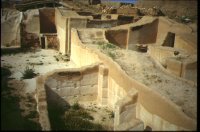|

Ebla


Ancient city of northern Syria, discovered in 1968 by the
Italian archaeologist Paolo Matthiae at Tell Mardikh, a 56-hectare (140-acre) mound south
of Halab (Aleppo). Excavating the site in 1975, Matthiae unearthed Ebla's royal archives,
a collection of more than 15,000 inscriptions on clay tablets dating from 2500-2200 BC.
Written in the cuneiform characters originated by the Sumerians of Mesopotamia, adapted to
the language of Ebla's Semitic inhabitants, they show the city to have been an important
commercial center ruled by a merchant aristocracy with an elected king. They also reveal
the existence of a flourishing north Syrian civilization rivaling that of Egypt and
Mesopotamia in the 3rd millennium BC.

In 1964, an
Italian expedition from university of Rome under the direction of Paolo
Mattiae has exposed the ancient Ebla (modern Tell Mardich) in central
Syria. In 1975 the palace library has been found. Around 15000 tablets and
fragments of tablets belonging to the early Bronze Age (2500 BC) were
found .The tablets were considered the oldest official documents in the
world. The tablets were written in 2 languages, the first is Sumerian and
the second is Semitic, the actual language of the eblaites and of many
other peoples throughout the Middle East. These texts have shed new light
on the leading commercial role of Ebla, which affected widely the commerce
relations and culture of Ebla and neighbor peoples in 3rd
Millennium.
Ebla showed 2 flourishing stages. The first was between 2500
–2200 BC, which showed the city to have an important commercial center
affecting both Mary and Akad. Main regions ruled by Ebla were Halab
(modern Aleppo in Syria), Mary, Byblos (modern Jubail in Lebanon), Emessa
(modern Homs),Emat (modern Hamah),Dimashki (modern Damascus), Karkamish (modern Jarablus in Syria), Ugarit,
(modern Ras Shamra in Syria). At the end of the first stage, Ebla was
conquered by Sargon I the Akadean.
The second stage was between 2200 – 1600 BC where Ebla ruled by
Shamashi Hadad, king of Halab. Hammorabi of Babylon conquered Ebla in 1750
BC.
There are many similarities between
Semitic language of Ebla and Arabic language.
|